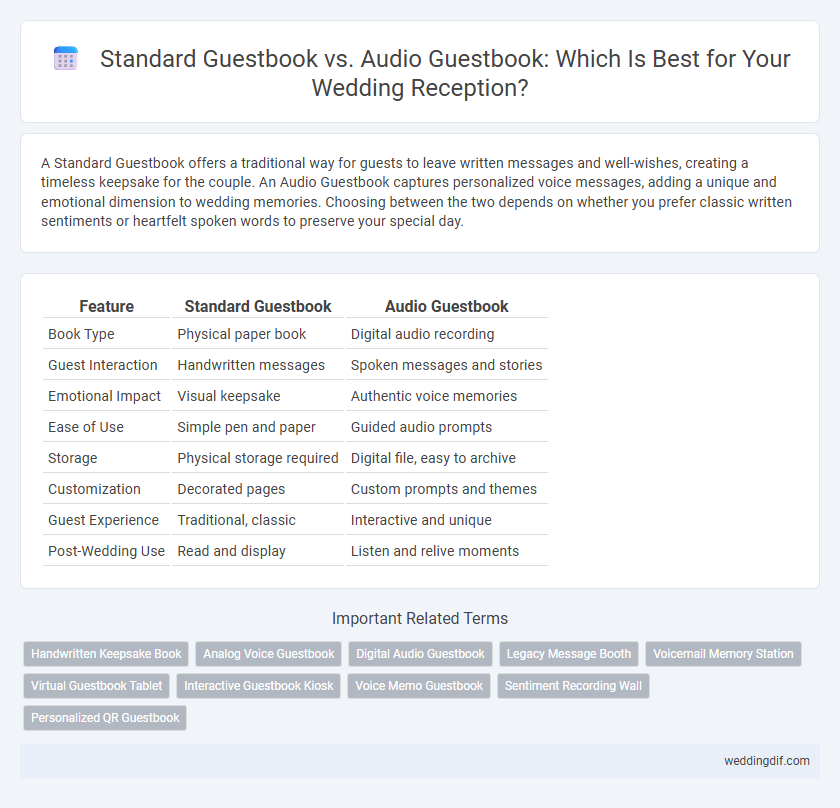A Standard Guestbook offers a traditional way for guests to leave written messages and well-wishes, creating a timeless keepsake for the couple. An Audio Guestbook captures personalized voice messages, adding a unique and emotional dimension to wedding memories. Choosing between the two depends on whether you prefer classic written sentiments or heartfelt spoken words to preserve your special day.
Table of Comparison
| Feature | Standard Guestbook | Audio Guestbook |
|---|---|---|
| Book Type | Physical paper book | Digital audio recording |
| Guest Interaction | Handwritten messages | Spoken messages and stories |
| Emotional Impact | Visual keepsake | Authentic voice memories |
| Ease of Use | Simple pen and paper | Guided audio prompts |
| Storage | Physical storage required | Digital file, easy to archive |
| Customization | Decorated pages | Custom prompts and themes |
| Guest Experience | Traditional, classic | Interactive and unique |
| Post-Wedding Use | Read and display | Listen and relive moments |
Introduction to Wedding Guestbooks
Wedding guestbooks capture cherished memories and messages from loved ones, serving as timeless keepsakes of the special day. Standard guestbooks offer a traditional approach with handwritten entries, while audio guestbooks provide an innovative way to record heartfelt voice messages. Couples choose between these options based on personal preference and the desired form of memento for their wedding reception.
What Is a Standard Guestbook?
A Standard Guestbook is a traditional keepsake where wedding guests write personalized messages, signatures, and well-wishes using pen and paper, creating a tangible memory for the couple. It usually features elegant designs, durable covers, and high-quality pages designed to complement wedding themes. This classic option offers a timeless and intimate way to capture guest sentiments without the need for technology.
Understanding the Audio Guestbook
The Audio Guestbook captures heartfelt messages and personal stories from guests, creating a unique and emotional keepsake that standard guestbooks cannot offer. Unlike traditional pen-and-paper guestbooks, it records voices, preserving tone, laughter, and emotion for a more vivid memory of the wedding day. This innovative approach enhances the reception experience by adding a dynamic and interactive element for friends and family to share their well-wishes.
Guest Experience: Writing vs Speaking
The Standard Guestbook offers a traditional, tactile experience where guests write personalized messages, preserving heartfelt notes and memories in a tangible, keepsake format. The Audio Guestbook enhances guest experience by capturing authentic voices and emotions, providing a dynamic and interactive way to relive the wedding day through spoken memories. Couples seeking a sentimental, visual memento may prefer writing, while those valuing emotional immediacy and candid expressions often choose the audio option.
Customization and Personalization Options
Standard guestbooks offer classic options such as personalized covers, custom fonts, and themed designs that reflect the couple's wedding style. Audio guestbooks provide a more interactive experience, allowing guests to leave personalized voice messages and stories, which captures emotions and sentiments beyond written words. Couples can enhance customization through digital interfaces with audio guestbooks, enabling tailored prompts and background music that create a unique keepsake.
Lasting Memories: Handwritten Notes vs Voices
Standard guestbooks capture lasting memories through handwritten notes, offering a tangible keepsake filled with personal messages and signatures from wedding guests. Audio guestbooks record voices, preserving the tone, emotion, and personality of each speech or comment for a more intimate, immersive memory. Couples seeking a traditional, visual memento often prefer standard guestbooks, while those wanting to relive authentic conversations choose audio guestbooks for a richer, multi-sensory experience.
Ease of Use for Guests
Standard Guestbooks offer a straightforward way for guests to leave written messages, requiring only a pen and simple instructions, making it accessible for attendees of all ages. Audio Guestbooks provide a more interactive experience by allowing guests to record voice messages, but this can require additional equipment and might be less intuitive for less tech-savvy guests. The ease of use for guests typically favors the Standard Guestbook due to its simplicity and minimal setup.
Storage and Preservation Considerations
The Standard Guestbook offers durable physical storage with the ability to preserve handwritten messages in a traditional format, ensuring easy archival and sentimental value over time. In contrast, the Audio Guestbook requires digital storage solutions such as cloud backup or external hard drives, providing convenience but necessitating ongoing maintenance to prevent data loss or corruption. Choosing between the two depends on whether the priority lies in tangible keepsakes or dynamic, long-term digital preservation.
Budget: Comparing Costs
Standard guestbooks typically range from $20 to $50, offering an affordable option for wedding receptions, while audio guestbooks can cost between $150 and $400 due to recording equipment and software requirements. Investing in an audio guestbook provides a unique, personalized keepsake with recorded messages, though it may exceed many couples' budgets. For budget-conscious weddings, standard guestbooks remain a cost-effective choice without compromising guest participation.
Choosing the Best Guestbook for Your Wedding
Choosing the best guestbook for your wedding depends on the atmosphere and interaction you want to create during your reception. A standard guestbook offers a timeless way for guests to leave personalized messages and signatures, ideal for couples who appreciate written keepsakes. An audio guestbook captures heartfelt voice messages, providing a unique and intimate memento that preserves the emotions and voices of your loved ones.
Standard Guestbook vs Audio Guestbook for wedding. Infographic

 weddingdif.com
weddingdif.com